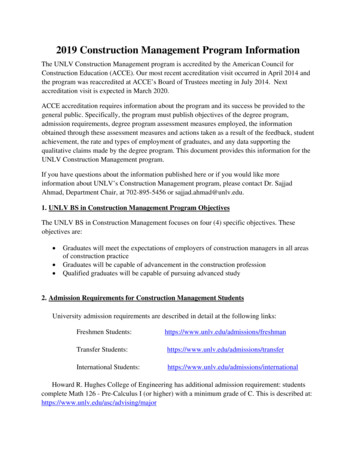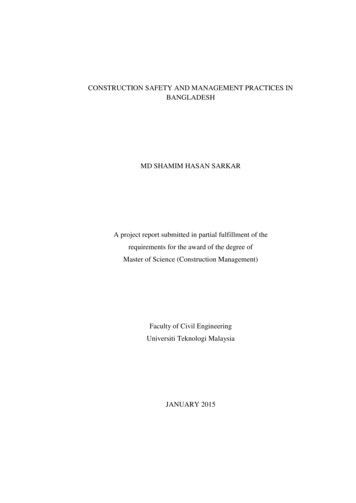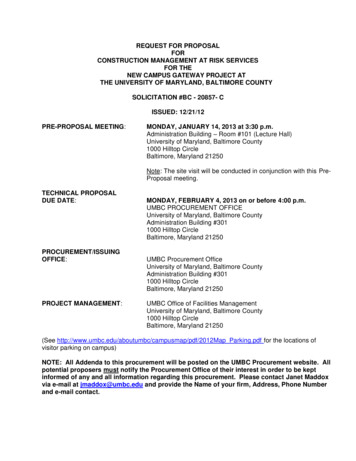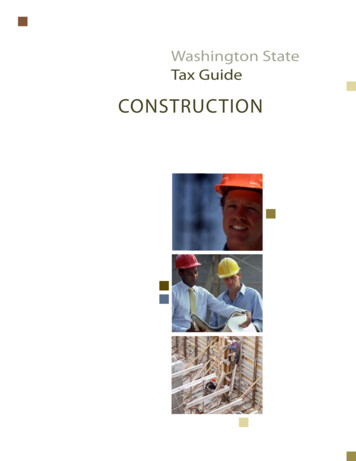
Transcription
2019 Construction Management Program InformationThe UNLV Construction Management program is accredited by the American Council forConstruction Education (ACCE). Our most recent accreditation visit occurred in April 2014 andthe program was reaccredited at ACCE’s Board of Trustees meeting in July 2014. Nextaccreditation visit is expected in March 2020.ACCE accreditation requires information about the program and its success be provided to thegeneral public. Specifically, the program must publish objectives of the degree program,admission requirements, degree program assessment measures employed, the informationobtained through these assessment measures and actions taken as a result of the feedback, studentachievement, the rate and types of employment of graduates, and any data supporting thequalitative claims made by the degree program. This document provides this information for theUNLV Construction Management program.If you have questions about the information published here or if you would like moreinformation about UNLV’s Construction Management program, please contact Dr. SajjadAhmad, Department Chair, at 702-895-5456 or sajjad.ahmad@unlv.edu.1. UNLV BS in Construction Management Program ObjectivesThe UNLV BS in Construction Management focuses on four (4) specific objectives. Theseobjectives are: Graduates will meet the expectations of employers of construction managers in all areasof construction practiceGraduates will be capable of advancement in the construction professionQualified graduates will be capable of pursuing advanced study2. Admission Requirements for Construction Management StudentsUniversity admission requirements are described in detail at the following links:Freshmen ransfer nternational onalHoward R. Hughes College of Engineering has additional admission requirement: studentscomplete Math 126 - Pre-Calculus I (or higher) with a minimum grade of C. This is described at:https://www.unlv.edu/asc/advising/major
The Department of Civil & Environmental Engineering and Construction does not have anyadditional admission requirements.3. UNLV BS in Construction Management (BSCM) Quality Improvement PlanA continuous improvement process ensures that the BSCM program provides students with thebest possible undergraduate education in construction and prepares them to become successfulconstruction managers. In that pursuit, the Construction Management Program strives to providethe following learning outcomes:Upon graduation from UNLV Construction Management Program a graduate shall beable to:SLO 1- Create written communications appropriate to the construction discipline.SLO 2- Create oral presentations appropriate to the construction discipline.SLO 3- Create a construction project safety plan.SLO 4- Create construction project cost estimates.SLO 5- Create construction project schedules.SLO 6- Analyze professional decisions based on ethical principles.SLO 7- Analyze construction documents for planning and management of constructionprocesses.SLO 8- Analyze methods, materials, and equipment used to construct projects.SLO 9- Apply construction management skills as an effective member of a multi-disciplinaryteam.SLO 10- Apply electronic-based technology to manage the construction process.SLO 11- Apply basic surveying techniques for construction layout and control.SLO 12- Understand different methods of project delivery and the roles and responsibilities ofall constituencies involved in the design and construction process.SLO 13- Understand construction risk management.SLO 14- Understand construction accounting and cost control.SLO 15- Understand construction quality assurance and control.
SLO 16- Understand construction project control processes.SLO 17- Understand the legal implications of contract, common, and regulatory law tomanage a construction project.SLO 18- Understand the basic principles of sustainable construction.SLO 19- Understand the basic principles of structural behavior.SLO 20- Understand the basic principles of mechanical, electrical and plumbing systems.Assessment Process for Student Learning OutcomesThe Civil and Environmental Engineering and Construction faculty has established and follows arobust process for evaluating the academic program and implementing changes toward our goalof continuous improvement. A variety of assessment tools gather information from students,faculty, alumni, and employers. Some provide direct measurements of student outcomes andothers provide stakeholder opinions on student outcomes, while some provide more generalprogram assessment information. The student outcome assessments and data collected fromalumni, industry, and stakeholders are reviewed every year in a dedicated faculty retreat, andsuggestions for improvement or changes are made and voted on by the faculty.Assessment Tools and Data CollectionThe following assessment tools are used:Course examinations and assignments. Most Construction courses utilize homework problems, quizquestions, and exam problems to assess student performance. These same measures link directly to studentlearning outcomes.Student term projects. Student projects are an important component of many courses and usuallyculminate with a written report, oral presentation, or both. Most projects require independent thinking toformulate a problem, identify possible approaches or solutions to the problem, and gather information tocomplete the project.Course evaluations. Students complete evaluations for each course near the end of the semester. Theseevaluations allow direct student input on instructor effectiveness and student learning outcomes, and alsoallow students to provide written comments. These results are provided to instructors at the end of thesemester. The Department Chair uses the results to provide broad feedback to all faculty members and asinput to annual faculty evaluations. In addition, the Department Chair uses these data to identify facultywho need teaching training, additional instruction support, or change in teaching strategies.Senior Exit Surveys. Each student is asked to complete (anonymously) a Senior Exit Survey that covers awide range of topics including Student Learning Outcomes and Program Objectives. These surveys arecompleted on-line near the end of their final semester (usually within 1 month of graduation). Results
from these surveys are shared with faculty and used, along with other assessment data, for learningoutcome assessment and program improvement.Senior Exit Interviews. The Department Chair interviews each graduating senior within a few weeks ofgraduation. These interviews usually last 30 minutes and consist partially of career mentoring, butprimarily provide students an opportunity to give direct input to the Department Chair. Students are askedto comment on facilities, support services (tutoring, advising, and career), instructors, courses and anyissues students may have encountered in the program and other areas of the University. Student inputs onProgram Objectives and SLO’s are also solicited during this interview.Alumni Surveys. An online survey is distributed to alumni to obtain input on the program based upon theirexperiences in the profession. Submissions are anonymous. Alumni Surveys are conducted every threeyears.Employer Surveys. An online survey is distributed to employers to obtain input based upon theirexperiences with graduates of the program. Submissions are anonymous. Employer surveys are conductedevery three years.Results from both Alumni and Employer Surveys are shared with faculty and used, along with other data,for assessment of learning outcomes and program educational objectives.AIC Exam. All Construction majors are required to take the AIC Exam prior to graduation. Detailedresults for each test taker are provided by AIC every year. The CEEC department has a course (CEM 455)dedicated to reviewing major topics for the exam. Students are required to make a good faith attempt forthe exam; it is not required to pass the exam to graduate.CEEC Industrial Advisory Committee. The CEEC Advisory Board, comprised of alumni and employersin civil engineering and construction, meets quarterly and provides general input about the program andits direction. Additionally, the Advisory Board Curriculum Committee meets independently and providesspecific input on curriculum matters. The Advisory Board completed a comprehensive review of allconstruction courses in Spring 2018 and provided input to the faculty for consideration. This review alsoserved to increase Advisory Board awareness of the curriculum content to improve their ability to provideuseful input.Additionally, graduation rates and student retention rates are carefully followed. While these arenot direct measures of student outcomes, they are extremely important to the university’s goal ofincreasing retention, and to the long-term health of the department, as they influence futureuniversity allocation of resources and faculty positions. A summary of assessment tools is shownin Table 1.
Table 1. Summary of assessment tools.External Assessments ToolsLabelDescriptionA1AIC Exam ResultsA2Employer SurveysA3Alumni SurveysA4Program Review by Advisory BoardInternal AssessmentsSection DescriptionA5Faculty Evaluation of Student Learning OutcomesA6Graduating Senior Exit SurveysA7Student Evaluation of all Class InstructorsA8-1Program Review (Major) by facultyA8-2Program Review (Minor) for Catalog UpdatesFrequencyOnce per YearEvery Three YearsEvery Three YearsEvery Three YearsFrequencyEvery SemesterEvery SemesterEvery SemesterEvery Three YearsEvery YearExternal assessments (A1-A4) are gathered from alumni and employers (through widelydistributed surveys), the CEEC Advisory Board, and AIC exam results. All collected assessmentdata are evaluated by the department’s Undergraduate Curriculum and Assessment Committee(UCAC). The UCAC makes recommendations to the faculty based upon those assessments. OurAdvisory Board meets quarterly with the Department Chair and provides direct feedback throughthat channel. The Department Chair or the UCAC (as appropriate) recommends potentialchanges to the faculty. Faculty discusses and votes on proposed changes. The Department Chairalso solicits input from the Advisory Board as issues arise where their perspective can bevaluable. The educational outcome assessment and continuous improvement cycle is shown inFigure 1.
Continuous Improvement CycleFigure 1. Course and program assessments and continuous improvement cycle.Internal assessments (A5-A8) are also integral to our continuous Quality Improvement Process.Information is gathered from graduating seniors, who are at a point to provide particularlyinsightful input, through a formal exit survey and one-on-one exit interviews with theDepartment Chair. While some of the input is duplicative, the different characteristics of the twoinstruments provide robust feedback and input for improvement. During the last weeks of eachsemester, students evaluate every offered course. These evaluations cover instructor performancein areas related to both classroom performance and levels of learning outcome attainment.Additionally, class instructors provide formal assessment of Student Outcomes through severalapproaches including, designated homework and examination problems, in-class assignments,and class projects and reports.Integration of inputs from a wide range of internal and external sources provides robustassessment of the CM program and outcomes. These assessments inform the faculty so they canmake an appropriate judgment about curriculum, teaching methods, course content, and changesnecessary to improve student learning and the quality of the program.
Flows of program assessment information and subsequent continuous improvement feedback areillustrated in Figure 2. The Department Chair or UCAC, as appropriate, initiates consultationwith faculty, and changes are implemented either through individual instructors at course level,or directly at the curriculum/program level. Progress as a result of changes made is monitored toensure improvements in the learning outcomes.Figure 2. Program assessment information flows and continuous improvement cycle.Evaluation of Collected Data and Decision MakingDirect and indirect assessment measures are employed to regularly evaluate our success inachieving these learning outcomes. These assessments collect information from all of ourconstituents – current students, graduates, alumni, employers, and interested communitymembers. These data are evaluated by the CM faculty with help from key Advisory Boardmembers to identify curricular and program changes to better attain the learning outcomes.Discussions of potential programmatic changes are initiated by CM faculty, presented to the
Department’s Undergraduate committee, and then voted on by the entire CEEC faculty. Onceapproved by the faculty, changes must also be approved by College and University CurriculumCommittees prior to implementation.This Quality Improvement Plan is a continuous process and assessment results are analyzedimmediately upon receipt. However, organized annual evaluations of all available assessmentresults are conducted during a daylong faculty retreat to ensure that the process leads to acontinuously improving program.4. Program Assessment MeasuresA range of instruments are employed to assess how well our program accomplishes the learningobjective and program outcomes. The measures employed and the schedule of their deploymentis as follows:Table: Assessment tools, frequency of use, and data collection procedureExternal Assessments ToolsType ofUsed to MeasureProcedure forLabelDescriptionFrequencyAssessment Achievement ofdata collectionOnce perReported byDirectSelected SLO’sA1AIC Exam ResultsYearAICEvery Three IndirectSLO and ProgramOn-line SurveyA2Employer SurveysYearsObjectivesEvery Three IndirectSLO and ProgramOn-line SurveyA3Alumni SurveysYearsObjectivesProgram Review byEvery Three IndirectSLO and ProgramReported byA4Advisory BoardYearsObjectivesIABInternal Assessments ToolsType ofUsed to MeasureProcedure forSection DescriptionFrequencyAssessment Achievement ofdata collectionFaculty Evaluation ofCollected andDirectSLOEveryStudent LearningReported byA5SemesterOutcomesInstructorGraduating SeniorEverySLO and ProgramIndirectOn-line SurveyA6Exit SurveysSemesterObjectivesStudent Evaluation of EveryTeaching qualityIndirectOn-line SurveyA7all Class InstructorsSemesterand SLOSummative SLO and ProgramReport byProgram ReviewEvery ThreefacultyA8-1Assessment Objectives(Major) by facultyYearscommittee
A8-2Program Review(Minor) for CatalogUpdatesEvery YearSummativeAssessmentSLO and ProgramObjectivesReport byfacultycommitteeAdditional assessments are employed as appropriate. The most recent data and assessments fromeach instrument are provided below.Performance CriteriaPerformance Criteria used to measure the achievement of the Degree Program Objectives andProgram Learning Outcomes is provided in following Table.Assessment ToolAIC Exam ResultsPerformance CriteriaPass rate equal to orbetter than nationalaverageScore of 3.5/5.0Employer SurveysScore of 3.5/5.0Alumni SurveysScore of 3.5/5.0Graduating Senior ExitSurveysFaculty Evaluation ofStudent LearningOutcomesStudent Evaluation ofall Class InstructorsProgram Review byAdvisory BoardProgram Review byfacultyPerformance thresholdset by individual facultyScore of 3.5/5.0Review and ApprovalMeeting or exceedingabove stated criteria forassessment toolsUsed to MeasureAchievement ofSelected SLO’sSLO’s; programquality; programobjectivesSLO’s; programquality; programobjectivesSLO’s; teachingquality, programquality; programobjectivesSLO’sSLO’s, teachingquality, programqualitySLO’s; curriculum,program quality;program objectivesSLO’s; curriculum,program quality;program objectives
Resultsa. American Institute of Constructors’ Associated Constructor Level I ExamConstruction Management Seniors takes the American Institute of Constructors’ AssociatedConstructor Level I – Construction Fundamentals examination as part of CEM 455 ConstructionManagement Practice. This course is taken in the student’s final semester. All students must takethe exam and the results comprise a portion of their course grade.The program uses this examination as a measure of academic quality. The goal established by theprogram is to exceed the national average pass rate on the exam. Historically, the performance ofUNLV CM students has exceeded that goal; the data are shown in the table below.Historical UNLV Student Results on American Institute of Constructors’Associated Constructor Level I ExamUNLV StudentsYearTakingPassing% PassingNational 8061201019178962200912119267The American Institute of Constructors’ Associated Constructor Level I Exam providessignificantly more information than just the pass rate. The table below shows the 2019 resultsfrom the 12 UNLV students who took the exam. UNLV students scored, on average, better thanthe national average in every subject area. Still, some areas were identified to be areas ofweakness by AIC. These include: Understand the principles of sustainable construction (SLO18); and Understand the principles of MEP (SLO 20). These areas (SLO 18 & SLO 20) are alsoconsidered areas of weakness nationally (based upon the national average score).
2019 Subject Area scores for UNLV students compared to the national average.Subject AreaSLO 1- Create written communications appropriate to theconstruction discipline.SLO 2- Create oral presentations appropriate to the constructiondiscipline.SLO 3- Create a construction project safety plan.UNLV NationalAvg.Avg.8075757175737572SLO 5- Create construction project schedules.7974SLO 6- Analyze professional decisions based on ethical principles.7773SLO 7- Analyze construction documents for planning andmanagement of construction processes.7673747076747872797270707676SLO 14- Understand construction accounting and cost control.7673SLO 15- Understand construction quality assurance and control.7974SLO 16- Understand construction project control processes.8379SLO 17- Understand the legal implications of contract, common, andregulatory law to manage a construction project.SLO 18- Understand the basic principles of sustainable construction.787667*58SLO 19- Understand the basic principles of structural behavior.7770SLO 20- Understand the basic principles of mechanical, electrical andplumbing systems.*considered to be an area of weakness by AIC64*59SLO 4- Create construction project cost estimates.SLO 8- Analyze methods, materials, and equipment used to constructprojects.SLO 9- Apply construction management skills as an effectivemember of a multi-disciplinary team.SLO 10- Apply electronic-based technology to manage theconstruction process.SLO 11- Apply basic surveying techniques for construction layoutand control.SLO 12- Understand different methods of project delivery and theroles and responsibilities of all constituencies involved in the designand construction process.SLO 13- Understand construction risk management.
b. Alumni and Employer SurveysAssociate Dean, College of Engineering deploys Alumni and Employer surveys every 3 years.Most recent survey was conducted in 2018. The surveys were designed so that each could bedeployed as singular survey to simplify delivery. This Alumni survey collects information on alldegree program in the college. Based on respondent’ selection of degree, a different set ofquestions are posed.While the 2018 survey results did not provide any startling results, there were some clear takeaway messages for the program. Overall, employers are satisfied with the program and ourgraduates. Alumni also are generally satisfied. Most Alumni chose “Agree” for most positivelystated questions rather than “Strongly Agree.” On the surface, this looks like all good news.However, we hoped for a much higher level of satisfaction from the biased audiences who tookthis survey. This tempered response likely results from a combination of factual observations, i.e.they truly have found areas in which we need to improve, and perception resulting fromhistorical communication with the University. This lack of overwhelmingly positive results ledto a complete review of the CM curriculum both by faculty and advisory board.Table 2. Student Learning Outcomes - Results from the Questionnaire for Alumni andEmployer Surveys (2018).Likert scale ratings range from 5 (strongly agree) to 1 (strongly disagree). Shaded cells showaverage scores below the 3.5 target rating of “Agree.”
Did your studies at UNLV help you develop the following capabilities?AlumniEmployerSLO 1- Create written communications appropriate to the constructiondiscipline.SLO 2- Create oral presentations appropriate to the construction discipline.4.14.434.44.57SLO 3- Create a construction project safety plan.4.34.43SLO 4- Create construction project cost estimates.4.64.67SLO 5- Create construction project schedules.4.64.33SLO 6- Analyze professional decisions based on ethical 674.14.673.94.50SLO 7- Analyze construction documents for planning and management ofconstruction processes.SLO 8- Analyze methods, materials, and equipment used to constructprojects.SLO 9- Apply construction management skills as an effective member of amulti-disciplinary team.SLO 10- Apply electronic-based technology to manage the constructionprocess.SLO 11- Apply basic surveying techniques for construction layout andcontrol.SLO 12- Understand different methods of project delivery and the roles andresponsibilities of all constituencies involved in the design andconstruction process.SLO 13- Understand construction risk management.SLO 14- Understand construction accounting and cost control.SLO 15- Understand construction quality assurance and control.SLO 16- Understand construction project control processes.SLO 17- Understand the legal implications of contract, common, andregulatory law to manage a construction project.SLO 18- Understand the basic principles of sustainable construction.SLO 19- Understand the basic principles of structural behavior.SLO 20- Understand the basic principles of mechanical, electrical andplumbing systems.Likert scale ratings range from 5 (strongly agree) to 1 (strongly disagree)
c. Senior Exit Interviews and SurveysSenior exit surveys and interviews are also important components of program assessment. Theyprovide essential student input on the program, its strengths, weaknesses, and areas of concern.First, students complete an online exit survey. Then the Department Chair interviews eachgraduate individually. Students are asked for their input related to all aspects of the program,including coursework, faculty, advising, career guidance, and any other related subject they maywish to raise. The Chair attempts to limit questions to clarification of specific points or asnecessary to stimulate a productive conversation. These unstructured, open-ended discussionstypically last 30 minutes each. Since data collected in this form is subject to bias, there is noattempt to gather quantifiable data. Instead, the Department Chair produces a summary of theinterviews that is distributed to the faculty and Dean. The summary focuses primarily onsynergistic issues raised by multiple graduates, although a critical issue raised by a singlegraduate could be sufficient to raise the concern to the faculty. Responses vary by issue, but thefaculty attempt to respond to each issue appropriately.The primary issue raised by the CM graduates during the Spring 2019 exit interviews was coursescheduling; they want more courses at night. This is an important issue that merits carefulconsideration. While I understand their concerns, it is not clear whether night or day courses arebest for the program’s growth. Currently, we start out with day classes at the freshman level,then transition our CM courses to later in the day with the senior level courses all being in theevening.The Exit Surveys provided more quantifiable information from the graduating students. Theresults are summarized in the Table below. In general, it shows widespread satisfaction with theCM program. It also shows that students believe that they successfully accomplished most of theStudent learning objectives established for the program. There were several areas of concernidentified (colored cells with score below 3.5) in 2017-2018 academic year. This issues werebrought to the knowledge of respective instructors and several changes were made in the contentand delivery. This has resulted in overall improvement in several SLO’s in 2018-2019 academicyear.Table 3. Student Learning Outcomes. Senior Exit Survey self-perception ratings studentlearning outcome attainment from 2017-2018 and 2018-2019 academic years Shaded cellsshow average scores below the 3.5 target rating.
Did your studies at UNLV help you develop the following capabilities?SLO 1- Create written communications appropriate to the constructiondiscipline.SLO 2- Create oral presentations appropriate to the construction discipline.2018 20194.03.833.83.833.03.83SLO 4- Create construction project cost estimates.3.24.17SLO 5- Create construction project schedules.3.43.67SLO 6- Analyze professional decisions based on ethical principles.4.04.50SLO 7- Analyze construction documents for planning and management ofconstruction processes.SLO 8- Analyze methods, materials, and equipment used to construct 4.03.00SLO 3- Create a construction project safety plan.SLO 9- Apply construction management skills as an effective member of amulti-disciplinary team.SLO 10- Apply electronic-based technology to manage the constructionprocess.SLO 11- Apply basic surveying techniques for construction layout and control.SLO 12- Understand different methods of project delivery and the roles andresponsibilities of all constituencies involved in the design and constructionprocess.SLO 13- Understand construction risk management.SLO 14- Understand construction accounting and cost control.SLO 15- Understand construction quality assurance and control.SLO 16- Understand construction project control processes.SLO 17- Understand the legal implications of contract, common, and regulatorylaw to manage a construction project.SLO 18- Understand the basic principles of sustainable construction.SLO 19- Understand the basic principles of structural behavior.SLO 20- Understand the basic principles of mechanical, electrical and plumbingsystems.Likert scale ratings range from 5 (strongly agree) to 1 (strongly disagree)
d. Individual Course AssessmentsInternal reviews monitor performance of faculty and students on a routine basis to identify issuesand concerns quickly and ensure program delivery and quality remains at a high level. Everycourse includes formal, anonymous evaluation by the students. The evaluation consists of threeparts, course content, faculty performance, and student comments. These reviews areadministered on-line and compiled by the UNLV to ensure anonymity. The results are providedindividually to each faculty member and collectively to the Department Chair. The DepartmentChair uses the information to identify potential strengths, weaknesses, and concerns, thenaddress those with individual instructors as appropriate. Actions are taken by the DepartmentChair, in consultation with the Dean, to remedy identified concerns as appropriate. Recently,course evaluation results have been summarized and distributed to all faculty in the followingform:Fall 2018 and Spring 2019 Teaching Evaluation Summary for Construction 03.4
These results are provided with this explanation of the color key: Green - Instructor did well; if you are at the low end of the spectrum,please continue your efforts to improve.Yellow - Instructor should commit themselves to improving yourinstruction and course management. However, if your course isunusually rigorous and that leads to a lower evaluation score, pleasecontinue to place quality over popularity.Red - Instructor needs to improve. Instructors in this category mustprepare a written self-assessment of their performance in the coursealong with a goal for the next evaluation and specific strategies/changesto achieve that goal. This plan must be submitted to the Chair and ameeting held to discuss the plan. (none in this review)Providing the data in this manner allows faculty to compare their performance with others in thedepartment while respecting instructors’ privacy. The results are used by individual instructor toimprove course delivery and content.CM Course/Curriculum Review by Advisory BoardAssessment results and the continual need to improve the program suggested that acomprehensive review of all existing CM courses in the program could potentially be useful.This review was conducted by the IAB Curriculum Committee in Spring of 2018 in theleadership of Mr. James Caviola.This intensive review of the CM curriculum provided useful insights into what local employersare looking for in BSCM graduates. It also served to better inform the participants of the rigorwithin the current program. Many verbal comments were made about how “surprised” they wereabout the depth and breadth of the curriculum; they found it to be much more that they expectedbased upon their previous understanding. It also served to provide a foundation for our futurediscussion on program changes.Committee suggeste
UNLV Construction Management program. If you have questions about the information published here or if you would like more information about UNLV's Construction Management program, please contact Dr. Sajjad Ahmad, Department Chair, at 702-895-5456 or sajjad.ahmad@unlv.edu. 1. UNLV BS in Construction Management Program Objectives









